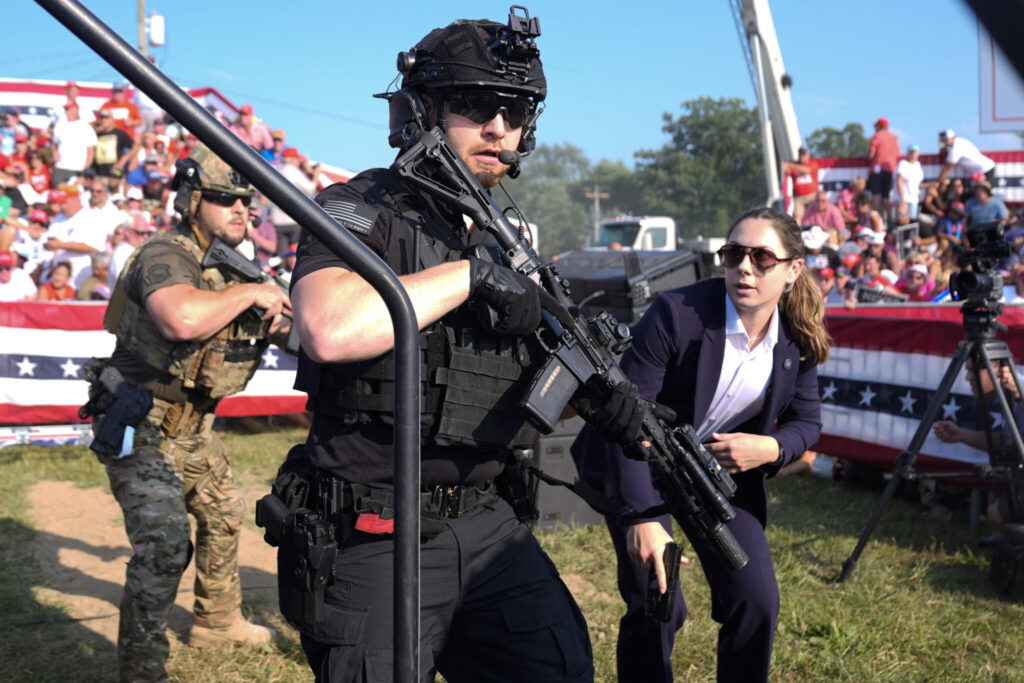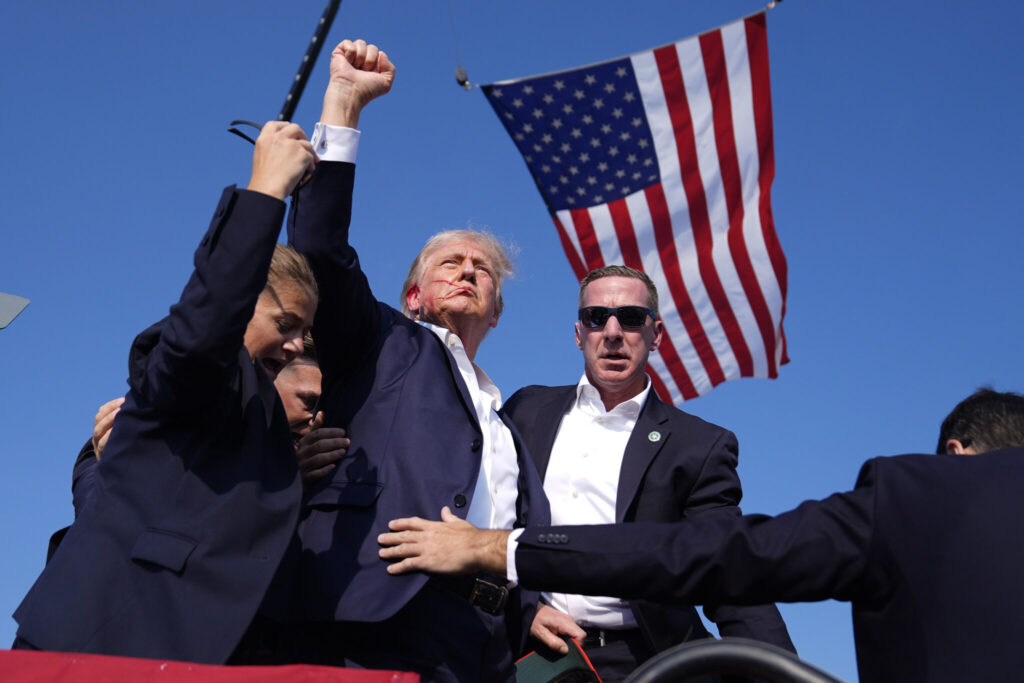Secret Service security lapses/ Trump rally security breach/ Secret Service breakdown/ Newslooks/ WASHINGTON/ J. Mansour/ Morning Edition/ A Senate investigation revealed that multiple Secret Service failures before a shooting at a Trump rally were “foreseeable and preventable.” The bipartisan report highlighted breakdowns in communication, security planning, and resource allocation. The July attack left one rallygoer dead, with Donald Trump narrowly escaping injury, and prompted calls for a major Secret Service overhaul.

Secret Service Failures Exposed in Trump Rally Shooting: Quick Looks
- Senate report found preventable Secret Service failures before a July rally shooting aimed at Donald Trump.
- Communication breakdowns and poor planning allowed a gunman to fire shots, injuring Trump and killing one rallygoer.
- The gunman, perched on a building, fired eight rounds before being killed by a Secret Service sniper.
- A two-minute warning about the shooter was not relayed to key personnel, leading to missed opportunities to protect Trump.
- Investigators found no clear chain of command, poor coordination, and lack of responsibility among Secret Service agents.
- Local law enforcement flagged security concerns before the event, but they were not addressed effectively.
- The Secret Service’s internal review and a separate House investigation are also examining the security failures.
- Lawmakers recommend better-defined roles, improved communication systems, and consideration of additional resources for the agency.
Senate Report: Secret Service Failures in Trump Rally Shooting
Deep Look:
A bipartisan Senate investigation has revealed that a series of avoidable failures by the Secret Service contributed to a shooting at a July rally for former President Donald Trump in Butler, Pennsylvania, where a gunman opened fire. The Senate Homeland Security and Governmental Affairs Committee released its findings on Wednesday, concluding that the lapses were “foreseeable, preventable, and directly related to the assassination attempt.” The attack left one rallygoer dead, two others injured, and Trump narrowly escaped with only a minor injury.
The report outlined significant security breakdowns at nearly every level of the Secret Service’s operations, including flawed planning, insufficient communication, and inadequate allocation of resources. Michigan Sen. Gary Peters, chairman of the Homeland Security Committee, described the consequences as “dire,” emphasizing that poor coordination among security agencies allowed the shooter to strike before any preventive measures could be taken.
Key to the committee’s findings was the absence of a clear chain of command among the Secret Service and local law enforcement agencies. Investigators found that multiple communication failures, including the use of different radio channels, hindered response times. An inexperienced drone operator, struggling with malfunctioning equipment, was unable to provide critical aerial surveillance, further complicating efforts to identify the shooter in time.
According to the report, Secret Service personnel received a warning about an individual on the roof of a building near the rally approximately two minutes before the shooter, identified as Thomas Matthew Crooks, opened fire. Crooks fired eight rounds at Trump, less than 150 yards from where he was speaking. One of the bullets or fragments struck Trump in the ear, though the former president was not seriously injured. The situation escalated quickly, leaving one rally attendee dead and two others wounded before Crooks was neutralized by a Secret Service counter-sniper.
Despite the clear threat, key Secret Service personnel were not informed in time to take action. Just 22 seconds before the gunfire began, a local officer radioed an alert about an armed individual, but that information never reached agents responsible for Trump’s immediate protection. In one startling account, a Secret Service counter-sniper recalled seeing other officers rushing toward the building with weapons drawn but failed to realize the urgency or alert others to remove Trump from the stage.
The Senate’s findings followed an internal Secret Service review released just days earlier. That five-page document summarized the agency’s initial conclusions, noting serious gaps in planning and oversight. The review, along with the Senate report, points to systemic issues within the Secret Service, including complacency among agents and an overall lack of accountability.
The bipartisan House task force, also investigating the rally shooting, is examining similar failures and is expected to release additional details in the coming days. Their probe extends to a second assassination attempt against Trump earlier in the month, when a man was arrested at Trump’s Florida club, hiding on the golf course with a rifle.
As each investigation uncovers new details, lawmakers are focusing on what they describe as a “massive breakdown” in Trump’s security. Sen. Rand Paul of Kentucky, the ranking Republican on the Homeland Security Committee, said the failures were the result of “multiple human errors” within the Secret Service. The senators recommended that the agency redefine roles and responsibilities for security planning, assign a single individual to approve all protective measures, and improve coordination with local law enforcement.
Interviews with Secret Service agents revealed confusion over who was in charge of various aspects of security at the rally. One advance agent admitted that security decisions were made collectively, with no one individual holding final responsibility. This lack of clarity contributed to the communication failures that allowed the shooter to go unnoticed for critical moments.
Local law enforcement had raised concerns about the security of the building Crooks used to stage the attack two days before the rally. During a site walkthrough, local officials informed Secret Service agents that they did not have enough manpower to secure the building. However, conflicting accounts from the Secret Service left it unclear who was ultimately responsible for addressing the vulnerability, leading to inaction.
The Secret Service’s internal review similarly cited the lack of clear guidance to local authorities, insufficient intelligence sharing, and a failure to correct known security vulnerabilities, such as ensuring line-of-sight coverage at the rally venue. Ronald Rowe Jr., acting director of the Secret Service, admitted the agency’s shortcomings, stating, “It’s important that we hold ourselves to account for the failures of July 13th.”
The Senate report offered a range of recommendations to improve Secret Service operations, including a complete overhaul of communications systems at protective events and better-defined security roles. The senators also called on Congress to evaluate whether additional funding is needed to enhance security protocols, though the issue remains contentious. A proposed spending bill includes $231 million in additional funding for the Secret Service, but many Republicans, including Wisconsin Sen. Ron Johnson, argue that internal management reforms are needed first.
“This is a management problem, plain and simple,” Johnson said, calling for a more comprehensive overhaul before allocating additional resources to the agency.
As investigations continue, lawmakers and security experts alike hope that the lessons learned from the July attack will lead to necessary reforms to ensure the safety of public figures in the future.







